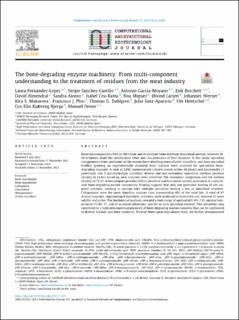| dc.description.abstract | Many microorganisms feed on the tissue and recalcitrant bone materials from dead animals, however little is known about the collaborative effort and characteristics of their enzymes. In this study, microbial metagenomes from symbionts of the marine bone-dwelling worm Osedax mucofloris, and from microbial biofilms growing on experimentally deployed bone surfaces were screened for specialized bone-degrading enzymes. A total of 2,043 taxonomically (closest match within 40 phyla) and functionally (1 proteolytic and 9 glycohydrolytic activities) diverse and non-redundant sequences (median pairwise identity of 23.6%) encoding such enzymes were retrieved. The taxonomic assignation and the median identity of 72.2% to homologous proteins reflect microbial and functional novelty associated to a specialized bone-degrading marine community. Binning suggests that only one generalist hosting all ten targeted activities, working in synergy with multiple specialists hosting a few or individual activities. Collagenases were the most abundant enzyme class, representing 48% of the total hits. A total of 47 diverse enzymes, representing 8 hydrolytic activities, were produced in Escherichia coli, whereof 13 were soluble and active. The biochemical analyses revealed a wide range of optimal pH (4.0–7.0), optimal temperature (5–65 °C), and of accepted substrates, specific to each microbial enzyme. This versatility may contribute to a high environmental plasticity of bone-degrading marine consortia that can be confronted to diverse habitats and bone materials. Through bone-meal degradation tests, we further demonstrated that some of these enzymes, particularly those from Flavobacteriaceae and Marinifilaceae, may be an asset for development of new value chains in the biorefinery industry. | |

